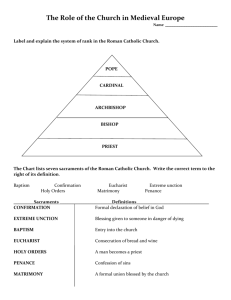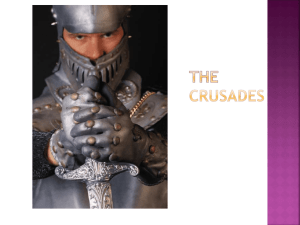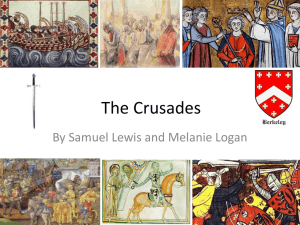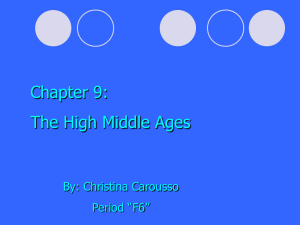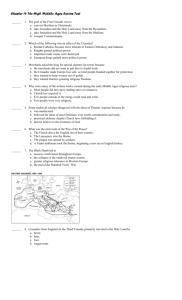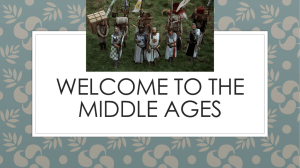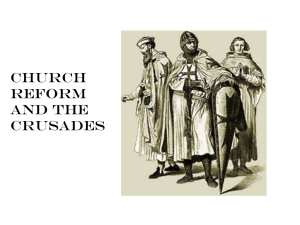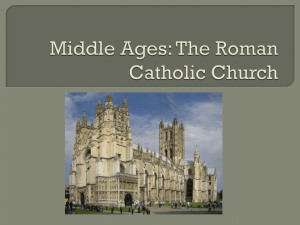Early Middle Ages Middle Ages: 500
advertisement
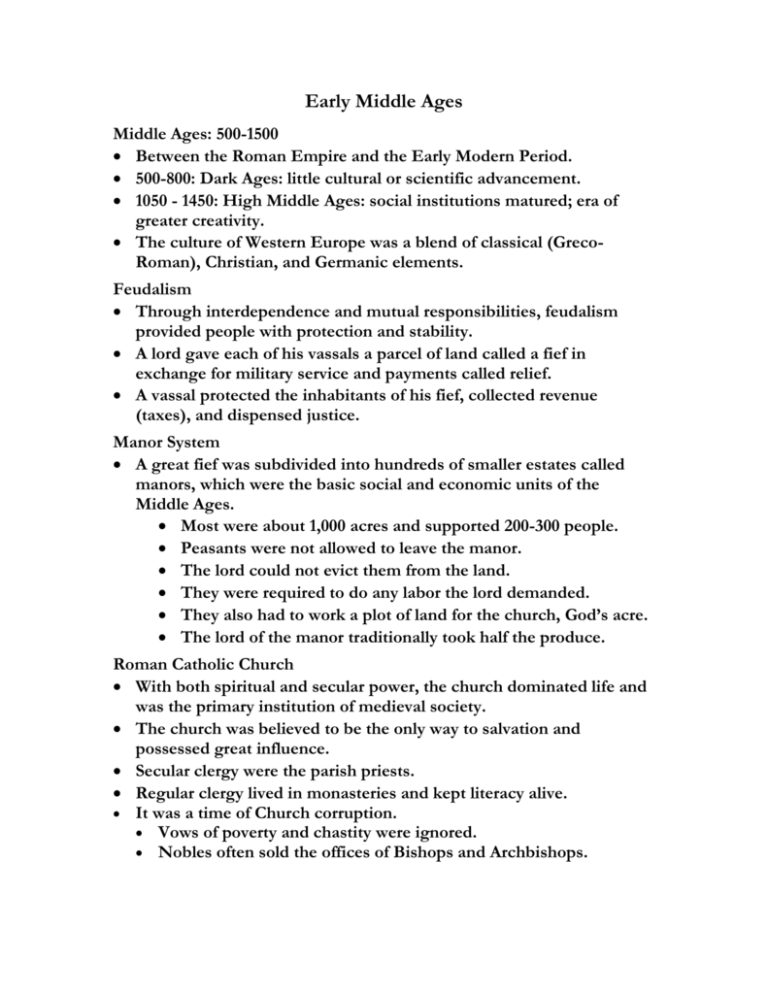
Early Middle Ages Middle Ages: 500-1500 Between the Roman Empire and the Early Modern Period. 500-800: Dark Ages: little cultural or scientific advancement. 1050 - 1450: High Middle Ages: social institutions matured; era of greater creativity. The culture of Western Europe was a blend of classical (GrecoRoman), Christian, and Germanic elements. Feudalism Through interdependence and mutual responsibilities, feudalism provided people with protection and stability. A lord gave each of his vassals a parcel of land called a fief in exchange for military service and payments called relief. A vassal protected the inhabitants of his fief, collected revenue (taxes), and dispensed justice. Manor System A great fief was subdivided into hundreds of smaller estates called manors, which were the basic social and economic units of the Middle Ages. Most were about 1,000 acres and supported 200-300 people. Peasants were not allowed to leave the manor. The lord could not evict them from the land. They were required to do any labor the lord demanded. They also had to work a plot of land for the church, God’s acre. The lord of the manor traditionally took half the produce. Roman Catholic Church With both spiritual and secular power, the church dominated life and was the primary institution of medieval society. The church was believed to be the only way to salvation and possessed great influence. Secular clergy were the parish priests. Regular clergy lived in monasteries and kept literacy alive. It was a time of Church corruption. Vows of poverty and chastity were ignored. Nobles often sold the offices of Bishops and Archbishops. Rise of Monarchies - England Feudal monarchs increased their power by gaining the support of townspeople. Growth of a money economy allowed monarchs to hire soldiers. England Battle of Hastings - 1066 Duke William of Normandy gains the English throne. He maintains firm control over his vassals. Recorded a census in the Domesday Book to make tax collecting more efficient. Common law was extended to all people and a jury system developed. Magna Carta - 1215 Barons forced King John to sign the “Great Charter,” which was later used to limit the power of the monarchy. Granted rights to the nobility, which were later extended to all citizens. Forced the monarch to abide by the law. Required the monarch to consult with the Great Council of lords and clergy before raising taxes. In the 1200s, meetings of the Great Council began to include representatives from the towns and lesser knights. These meetings became known as Parliament. Two groups eventually formed. House of Lords: nobles and high clergy (bishops) House of Commons: lesser knights and middle class citizens (townspeople) A limited monarchy developed as Parliament increased its financial and legislative powers. Rise of Monarchies – France, Holy Roman Empire & Spain France Hugh Capet, Count of Paris, elected king by feudal lords in 987. Established the Capetian dynasty that lasted 300 years. Increased royal lands through diplomacy, marriage, and war. Established efficient bureaucracy. Districts were administered by educated clergy, lesser knights, and townspeople. 1302 - Estates General formed to represent the clergy, the nobility, and the townspeople (bourgeoisie). It never became as powerful as the Parliament. Holy Roman Empire Otto I, Duke of Saxony, elected king of the Germanic states in 936. He centralized power over the German and Italian states and formed close ties with the Church. Pope John XII crowned Otto “Emperor of the Romans” in 962. Title claimed by Otto’s successors. Not holy, Roman, nor an empire. The emperors never had as much control as the nobility. The power struggle between emperors and popes was an ongoing affair throughout the Middle Ages. The practice of lay investiture, wherein the emperor gave a new bishop the symbols of his office (a ring and a staff), became a big issue in the 1000s. In 1122, at the Concordat at Worms, a compromise was reached where church officials elected bishops and abbots and invested them with spiritual authority and the emperor granted them lands and secular powers. Spain Reconquista- Ferdinand of Aragon and Isabella of Castille finally drove out the Muslims in 1492. Crusade to bring political and religious unity followed. Religious toleration ended. Muslims and Jews who refused to convert to Christianity were tried by the Inquisition and often killed. Many skilled and educated people emigrated. Crusades Goal: to liberate the Holy Land. 1071: Seljuk Turks took over Palestine and were torturing Christians. 1095: Byzantine Emperor asked Pope Urban II for help. Thousands of knights and peasants sewed large crosses on their tunics and set out for the Holy Land. Few would return. For many, the crusades appealed to their desire for wealth, honor, sense of adventure, freedom from serfdom, freedom from debts, and hope for spiritual salvation. Between 1096 and 1204, there were 4 major crusades, a peasant’s crusade, and 2 children’s crusades. Minor crusades continued until 1270. Only the 1st Crusade was successful. In 1099, after Muslims and Jews were massacred in Jerusalem, the crusaders divided the captured lands into four Crusader States: Edessa, Antioch, Tripoli, and Jerusalem. Within 50 years, the Muslims began regaining control. After the fall of Edessa in 1144, the 2nd Crusade was called by Saint Bernard of Clairvaux. It was a total failure. After the 3rd Crusade, the Muslim leader Saladin allowed Christians to go to Jerusalem for religious pilgrimages. Encouraged by Venetian merchants, the 4th Crusade attacked and looted Constantinople. By 1291, the city of Acre, the last Christian outpost, was captured by Muslims, who massacred their defeated enemies, the Christians. The Crusades failed in their chief goal - the conquest of the Holy Land. Outcome : briefly increased the power and prestige of the pope increased the power of monarchs who levied taxes to support the Crusades increased trade between east and west rise of towns encouraged the growth of a money economy in Western Europe selling goods for a profit became acceptable Italian merchants and shipbuilders got rich by maintaining the supply lines and transportation to the Holy Land. contact with other civilizations opened minds to new ideas sparked an interest in exploration increased persecution of Jews thousands were slaughtered & much property was destroyed Learning, Literature, and the Arts 1100s - first universities evolved out of cathedral schools Literature began to be written in the vernacular (everyday language of the people) rather than in Latin only. Scholasticism was developed by Christian scholars to resolve the conflict between faith and reason. Thomas Aquinas: Summa Theologica - brought classical Greek philosophy together with Christian faith Chanson de geste - long narrative poems that portrayed the ideals of chivalry - such as the Song of Roland and the Poem of the Cid Christine de Pizan: The City of Ladies - examined the achievements of women and men’s negative views of women troubadour poems of love were popular among the nobility Dante : Divine Comedy - Roman poet Virgil leads Dante on a visit to hell, purgatory, and later heaven Geoffrey Chaucer : The Canterbury Tales - pilgrims on their way to the tomb of Thomas Becket in Canterbury in southern England The theme of all medieval art was religion. Illuminated manuscripts Great cathedrals were built: Romanesque style: 1000 - 1150 thick walls, rounded arches and domed roofs narrow slits for windows simple, solid, dark, gloomy fortress flat, masculine, and simply adorned Gothic style: 1150 - 1300 tall, light, and airy flying buttresses large stained glass windows complex, lacy, richly embroidered, feminine Despite the lack of scientific observation and experimentation and the unquestioned authority of the Catholic Church, some scientific progress was made. 1200s - Roger Bacon : founder of experimental science Medicine was still poor - illness was the work of the devil herbal folk medicine, prayer, and pilgrimages to holy shrines Late Middle Ages 1200s - rise of towns The growth of towns and a middle class weakened the position of the nobility. Increased trade created a money economy, which replaced the barter economy. Monarchs were able to hire soldiers for standing armies to protect the people and they no longer relied on vassals for support. Strong monarchs undermined feudal nobility. 1300s - challenging century social unrest - peasant revolts bad weather & crop failures early in the century - hunger and starvation divisions in the Church Babylonian Captivity: 1309 - 1378 heresies : Wycliffe and Hus military conflict - Hundred Years’ War ~ 1337-1453 ~ England v. France New weapons such as the longbow and cannons made armored knights obsolete and castles indefensible. Many nobles died during the war. illness and death - the Black Plague killed 1/3 of the population economic transformation growth of banking and capitalism decline of feudal and manorial systems weakening of the guild system emergence of the domestic system - merchants hired laborers who were paid for piecework 1400s - time of change Strong national monarchies arose in England, France, and Spain to form centralized governments. Most serfs were emancipated. There was a flourishing in the arts and literature - the Renaissance. Inquisition - court established by the Catholic Church in the 1200’s to locate and try heretics - actively persecuted Jews, Muslims, and alleged witches. Renaissance: 1350-1550 rebirth of interest in classical learning Humanism intellectual movement that focused on worldly subjects rather than religious issues promoted the study of grammar, rhetoric, poetry, and history Golden Age of the Arts: painting, sculpture, architecture realism of the Romans and idealistic beauty of the Greeks perspective - making distant objects appear smaller than objects closer to the viewer rejected Gothic architecture in favor of the columns, arches, and domes of classical times Why Italy? center of Roman civilization wealthy and powerful merchant class stressed education and individual achievement and had the financial resources to support the arts patron - financial supporter of the arts Florence - center of the Renaissance Leonardo da Vinci: Renaissance Man person of wide interests and an expert in many areas artist and student of botany, anatomy, optics, music, architecture, and engineering Northern Renaissance 1400s - Flanders : northern France, Belgium, and the Netherlands 1500s- Spain, France, Germany, and England emphasis on religious themes Printing Press 1456 - Johann Gutenberg of Germany printed the Bible using movable metal type Scientific Revolution 1600s - Scientific Method used rather than reliance on the Bible, Aristotle, Ptolemy heliocentric (sun-centered) model of the universe gravity theorized by Isaac Newton advances in chemistry and medicine Reformation Martin Luther - German monk and professor of theology (religion) 1517 - wrote the 95 Theses arguing against the sale of indulgences (pardon of sins) and nailed them to the door of the Wittenberg Church Main Ideas salvation comes through faith alone - not by good works Bible is the sole source of truth priests are not needed to interpret the Bible Spread of Luther’s ideas many people in Germany and Scandinavia unhappy with Catholic Church corruption became Protestants German princes saw the movement as an opportunity to throw off the rule of the Church and the Holy Roman Emperor they were tired of giving money to Rome and wanted to seize Church property Peace of Augsburg - 1555 princes in the Holy Roman Empire could chose their religion south stayed Catholic (Italy) north became Protestant (Germany) John Calvin: 1536 accepted Luther’s idea of salvation through faith alone original sin - humans are born sinful predestination - God predetermined who would be saved believers led moral lives and had a strong work ethic set up as a theocracy in Geneva Switzerland - govt. ruled by church leaders Huguenots - French Calvinists John Knox led Calvinists in Scotland English Reformation King Henry VIII wanted to annul his marriage - pope refused 1534 - Act of Supremacy : king became the head of the Church of England (Anglican Church) maintained Catholic rituals - but services were conducted in English and priests could marry Radical Reformers Anabaptists rejected infant baptism Amish, Mennonites, Quakers, Baptists Catholic Reformation revived moral authority of the Church and ended corruption Council of Trent (1545-1563) - reaffirmed traditional views salvation - faith and sacraments Bible and pope are sources of truth Effects of the Reformation religious wars in Europe for 100 years Inquisition becomes stronger many Jews are forced into Eastern Europe

